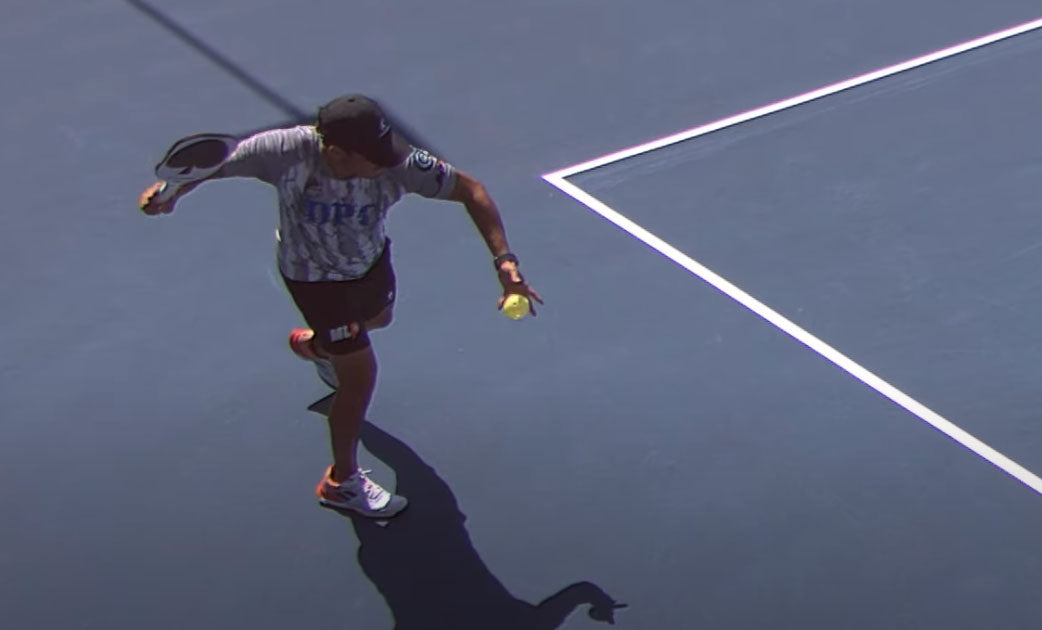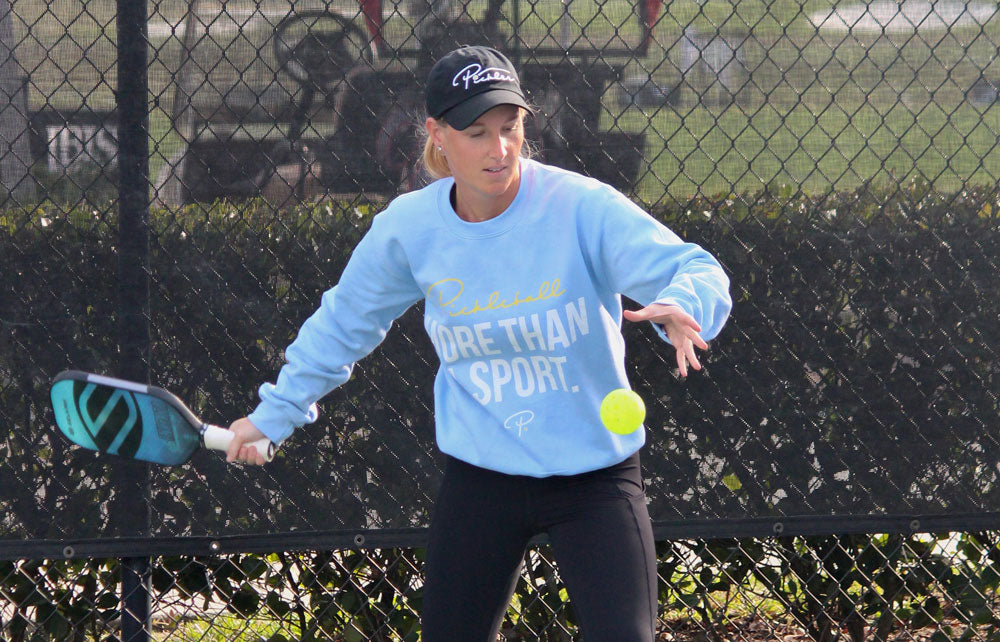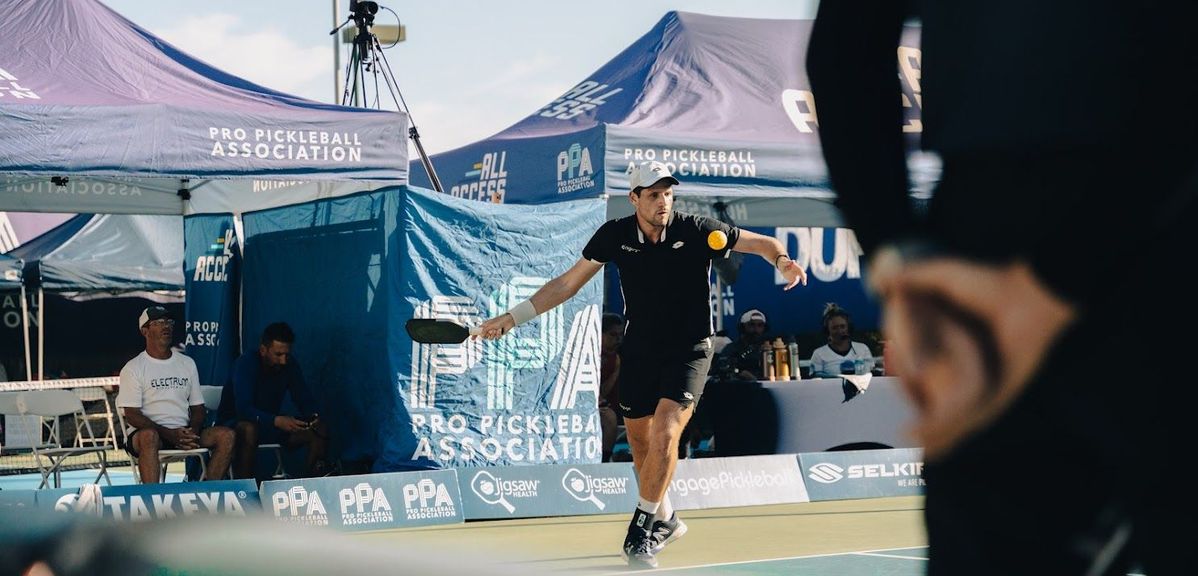The pickleball power serve: unleashing domination from the start
The serve is the first shot in a pickleball game, and a Pickleball power serve can set the tone for the entire point, providing a significant advantage over your opponent. Mastering this skill not only builds confidence but also influences how your opponent will respond. It’s vital to appreciate that while the concept of a powerful serve may seem intimidating, it can be mastered with the right technique and practice. By understanding the fundamental elements involved in executing a powerful serve and employing effective strategies on the court, you can develop a serve that both impresses and intimidates your opponents. Whether you’re an amateur or a seasoned player, enhancing your serve can lead to more consistent wins and a more commanding playing style.
Understanding the fundamentals

Stance and grip: setting the stage for a powerful serve
The importance of a proper stance cannot be overstated when it comes to generating power in your serve. The initial setup involves a balanced, open stance, where your feet are shoulder-width apart, with your dominant foot slightly forward, pointing towards the net. This positioning allows for optimal weight distribution and prepares you for a smooth swing. Balancing your weight correctly is paramount; if your weight is uneven, it can lead to a loss of control and power.
Equally critical is your grip on the paddle. The continental grip is widely regarded as the most effective for executing power serves. To use this grip, hold the paddle like a handshake, ensuring the paddle face is perpendicular to the ground. Your thumb should rest along the side of the paddle handle while your index finger extends along the top. Another option is the eastern forehand grip, which can provide additional power and spin. To perform this grip, start by holding the paddle as if shaking hands and then rotate your hand clockwise, so your index finger points towards the 12 o’clock position.
Mastery of both stance and grip will set a solid foundation for your serve technique. When you feel balanced and secure, you are more likely to execute a powerful and controlled serve.
Paddle preparation
In the moment before you serve, where you position your paddle can make a world of difference. Ideally, the paddle should start near your side, angled downwards. This position allows for a more fluid and powerful swing, helping in the momentum generation necessary for a strong serve.
Before starting the swing, ensure that your dominant hand is relaxed on the paddle. A tense grip can negatively affect both control and the natural flow of the swing. The basic rule is to keep a relaxed hold while allowing sufficient firmness to maintain control. This balance of relaxation and grip strength will assist in generating the necessary whip-like motion during the serve.
Body mechanics
When discussing the body mechanics involved in a power serve, the role of core strength is pivotal. Your core acts as the engine that drives the entire motion, providing stability and power. A powerful serve does not stem merely from arm strength; it requires a coordinated effort from your core, legs, hips, shoulders, and arms. Engaging your legs and allowing them to drive the motion as they transfer weight from back to front will amplify your downforce, further enhancing the speed of your serve.
Understanding how to incorporate fluid motion involving your hips and shoulders plays an influential role in serving technique. Think of your body as a coiled spring; when you uncoil that spring, you release all the stored energy into your swing, resulting in a powerful serve.
Mastering the Pickleball power serve technique
The backswing: maximizing power potential
One of the most critical aspects amidst your serve strategy is the backswing. By executing a controlled and deliberate backswing, you can maximize potential power. The key to a powerful serve is how effectively you prepare for your forward swing.
Begin your backswing by bringing the paddle back in a smooth arc, keeping your elbow high and close to your body. The paddle’s angle should be such that it sets you up for a dynamic motion when transitioning to the forward swing. It is at this moment that your body rotation plays a vital role engage your core and let your hips follow through smoothly to gain optimal momentum.
Make sure to practice this phase until it feels natural; a rushed or sloppy backswing can jeopardize not just power, but accuracy as well.
The forward swing: delivering control and accuracy
As you transition from your backswing to the forward swing, the power of your serve can shine through. Drive the paddle forward using your entire body, particularly your legs and core. The key is to maintain focus on the ball and target while executing a smooth forward swing.
When it comes to contact point, aim to hit the ball slightly in front of your body, using a downward motion to feature a controlled angle. This angle can direct the ball into effective placements, making it harder for your opponent to return.
Moreover, don’t neglect the follow-through after making contact. A controlled follow-through sustains balance and guarantees accuracy, aiding in the preservation of your technique. A clean follow-through will make your serve look polished and deliberate something not easily replicated.
The hip snap: enhancing power and spin
An often undervalued component of a powerful serve is the hip snap. Engaging your hips with a snap motion creates extra power and spin, elevating the effectiveness of your serve. To effectively utilize this technique, focus on synchronizing your hips with your paddle motion. When you serve, allow your hips to drive the speed of your arm by rotating and following through after contact.
By practicing this hip snap, you will find an addition to your serve’s arsenal that can make your shots unpredictable and difficult for opponents to read.
Essential drills for power serve development

Wall drills: building consistency
One impactful way to develop both your backswing and forward swing is through wall drills. Find a wall with ample space and start serving against it. Focus on your backswing, ensuring you bring the paddle back in a controlled manner, followed by a deliberate swing.
To improve power and accuracy, vary your distance from the wall and experiment with your grip and stance. To facilitate skill-building, consider the following variations:
- Hitting from different distances.
- Incorporating movement before each serve.
- Adjusting your grip style throughout your sets.
Serve-and-return drills: real-life applications
Integrating drills into your practice that mimic game scenarios will greatly improve your serve consistency. Serve-and-return drills focus on practicing the complete power serve motion in real-time, creating a game-like environment.
Challenge your partner to react to your serves and return them, providing actual feedback in terms of speed and placement. Here are variations you can try:
- Targeting specific areas of the court while serving.
- Differentiating power levels some serves soft, some hard.
- Incorporating spin into your serves during practice.
Serve-and-volley drills: strategic integration
To fully meld your new serving techniques into your gameplay strategy, serve-and-volley drills are essential. This type of drill not only incorporates the power serve but also helps you establish timing and court coverage.
When executing these drills, focus on your serve placement, timing your approach to the net, and positioning yourself for a volley post-serve. Variations could include:
- Using slice serves one round and topspin the next.
- Practicing with a partner focusing solely on your responses post-serve.
- Experimenting with placements serving to different zones based on where the ball comes back.
Advanced techniques for power serve enhancement

Spin serves: manipulating trajectory
An advanced tactic in enhancing your serve is to add spin to the mixture. There are various types of spin serves topspin, underspin, and sidespin each impacting the ball’s trajectory and bounce differently.
Topspin, for example, will cause the ball to bounce higher, while a slice serve may send the ball curling away from your opponent. Overall, adding these spin variations not only increases the ball’s speed but also complicates your opponent’s return, keeping them guessing.
Incorporating spin into your power serve requires focus. As you swing, adjust your contact point and paddle angle to facilitate the correct spin. Experimenting with different kinds of spin can add layers to your serving repertoire, catching opponents off-guard consistently.
Serve placement: exploiting weaknesses
Effective serve placement is a tactic that cannot be overlooked. The ability to strategically target your serves based on your opponent’s weaknesses can result in a substantial scoring advantage. Analyze the positioning and tendencies of your opponent to optimize your serve placements.
When planning your serves, consider:
- Serving to a backhand if your opponent struggles with that side.
- Targeting the corners of the service box to force difficult retrievals.
- Pump-faking or disguising your serve to mislead your opponent.
Serve deception: keeping opponents on their toes
Variability is crucial to any successful serving strategy. By varying your serve speed, spin, and trajectory, you can maintain an element of unpredictability that will frustrate your opponent.
Be wary of maintaining a consistent serve motion, as abrupt changes may alert your enemy to an upcoming challenge. Instead, work on different serve types flatter serves, high topspin loops, or deceptive slice serves while abiding by a similar motion. This keeps your tactics hidden while procuring effective and varied serves.
Practice tips for mastering the power serve
Slow motion: critically analyzing your form
An invaluable technique to continue improving your serve consists of filming your practice sessions while serving. After filming, slow down the footage and analyze your form. Look out for areas of strength and any potential errors this will provide insight that may not be immediately obvious during live play.
Focus on elements like grip, body positioning, swing path, and follow-through. Identifying these aspects will equip you with clues to improve your technique.
Drill work: integrating repetition and accuracy
Drill work is fundamental to building a consistent and powerful serve. Dedicate sessions solely to serve repetitions, permitting focus on accuracy and power alike. Repeat specific serves ideal placements, speed, and spins until the execution becomes second nature.
Emphasis on:
- Practicing various types of serves within a single session.
- Maintaining a steady rhythm in your serves.
- Rotating partners to develop adaptability in your serve.
Game play: real-world application
Lastly, the best test for your skills remains actual gameplay. Actively incorporating your power serve into matches allows you to develop confidence and formulate a game plan around it. Challenge yourself to utilize different strategies and serve types during games to gauge what works best against different opponents.
Evaluate your outcomes and seek feedback from peers to refine your skills continually.
FAQs
Can anyone learn to hit a powerful pickleball serve?
Yes, anyone can learn to hit a powerful pickleball serve! With proper technique, practice, and dedication, players at all skill levels can enhance their serve.
What is the difference between a flat serve and a spin serve?
A flat serve is characterized by a direct shot that travels fast and straight, whereas a spin serve creates rotation on the ball affecting its speed, bounce, and trajectory, making it harder for opponents to return.
What are some of the most common mistakes players make when hitting a power serve?
Common mistakes include improper grip, lack of body weight transfer, poor timing in the swing, and failing to follow through correctly. These can result in reduced power and accuracy.
How does the power serve in pickleball compare to the serve in tennis or badminton?
While all these sports feature serving techniques, the power serve in pickleball tends to emphasize shorter distances, leading to more opportunities for strategies such as spin and placement varieties, compared to tennis or badminton.
Conclusion
Mastering the pickleball power serve is a key to unlocking a more dominant and enjoyable game. By understanding the fundamentals involved in this essential skill and practicing the right techniques, you can develop a serve that will not only impress your opponents but also help you win more points. Remember that consistency, practice, and adaptability are key components of a strong serving game. Start practicing your power serve today and unleash your potential on the court. The transformation in your skillset and confidence will likely leave you amazed at how much your game improves!
